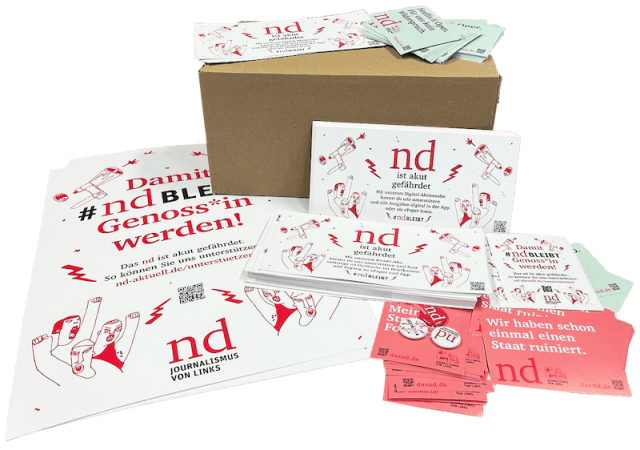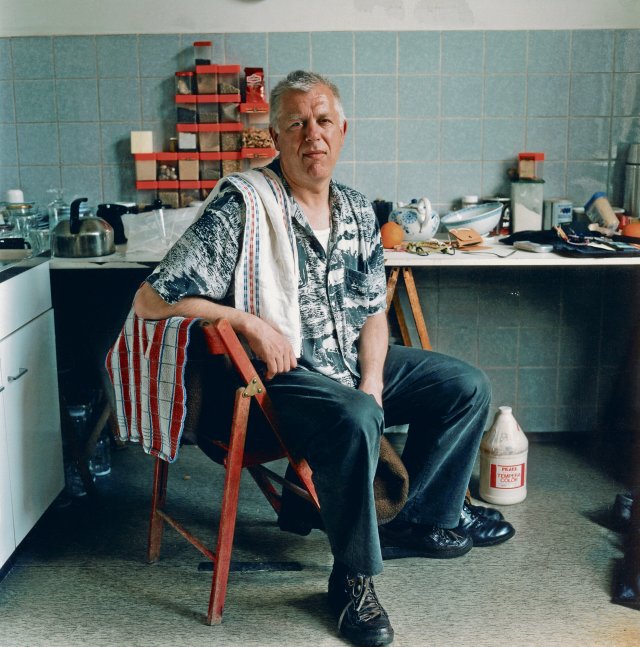Backstage at the Deutsches Theater Berlin, 1997: Einar Schleef between shoes and spices
Photo: Ostkreuz/ Ute Mahler
In Germany, as Elfriede Jelinek put it, there were only two geniuses after the Second World War. In the West that was the filmmaker Rainer Werner Fassbinder; and in the east – Einar Schleef. Genius is a very overused term. And how certain is it that Jelinek would resort to it again today? The smell of the century before last clings to him far too strongly; it is a word that has no feminine form. The superlative genius ultimately only blinds you to the brilliant details. In general: “Genius is interest,” as Brecht says.
But what word can you use to approach someone like Einar Schleef without conjuring up false images? Maybe like this: After the Second World War, there was another great universal artist in Germany, and his name is Schleef. He was born in Sangerhausen in 1944.
nd.DieWoche – our weekly newsletter

With our weekly newsletter nd.DieWoche look at the most important topics of the week and read them Highlights our Saturday edition on Friday. Get your free subscription here.
He brought the choir back to the theater. As a director as well as set and costume designer, as a playwright and actor, he amazed the directors and the audience in the East, in the West and in the New German East-West conglomerate and sometimes drove them crazy. Hardly any other theater artist would have been involved in so many stage works that were never completed or abandoned. But when Schleef brought works ready for premiere, they had such an impact that people are still talking about them today, decades later. Schleef anecdotes are still fodder in theater canteens. Not to be forgotten is his monumental essay “Droge Faust Parsifal”, published in 1997, evidence of a radical view of German cultural and thus also theater history.
But as an author, Schleef did not limit himself to just a few genres. His two-volume magnum opus “Gertrud,” named after his mother, can rightly be described as the novel of the century. He also wrote stories. As recently became known, he also left behind a lyrical work that is worth reading. In addition, there are hardly manageable chronological writings: a few thousand pages of diary documenting almost half a century, published in five volumes by Suhrkamp-Verlag; and then there is the extensive correspondence between mother and son.
An artist who worked on and in front of the stage and a writer who writes a lot and happily changes genres – that alone should make a universal artist? Einar Schleef, trained at the Berlin-Weißensee School of Art, was initially a visual artist. As a painter and graphic artist, he has created a work that is unfairly overshadowed by his theater work. And just like that, he also worked as an illustrator, photographer, radio playmaker and filmmaker. Unlike many artist colleagues, he never became a copyist of himself. Schleef created an original, sometimes surprising work for each art form.
It makes sense that someone who didn’t want to restrict himself artistically would be drawn to the theater. All the sister arts that interested Schleef come together here. He created great pictures on stage. Above all, he fought for literary theater in the truest sense of the word. He worked through language with his players. The maestro boasted that he had first taught the actors to speak. He himself was a stutterer.
This Schleef was not a humanitarian. There was and is some talk of torturous rehearsals. But the artist’s pedantry was never an end in itself, but rather a testimony to an artistic self-image. Art is not a coincidence, but the result of precise work. And if the friendly tone has to give way to direct instruction, this is not due to a weakness of character, but is a sign of shared belief in the cause of art. The fact that professional critics and the general public today are sometimes more interested in good people than in good art would probably have left Schleef shaking his head.
But how do you get to know the work of a universal artist after his death? Where do you start, where do you end? Nothing could be simpler than that: the person infected with the virus should not care where the infection occurred. Once your interest is aroused, you can collect the traces like a treasure hunter. For recordings of the theater productions, you will have to go into archives; Individual snippets of scenes from this can be found in documentaries – such as the snippets from “A Sport Play” at the Burgtheater Vienna that create tension after a fraction of a second.
Performances filmed in poor quality over hours from the auditorium that don’t let you go can be found on the Internet. Cheap paperbacks with Schleef’s prose can be bought secondhand for cents; Very limited bibliophile editions of individual texts require a small fortune. Schleef’s artistic work is rarely exhibited. So you’ll have to look for it!
And if you are not immune to Schleef fever, you should let us tell you about his work. Anyone who has met him has stories to tell. Do you already know this: After the premiere of “Wessis in Weimar” directed by Einar Schleef – the year is 1993 and we are in the Berliner Ensemble – the Brecht heiress Barbara Schall called the theater maker. She, who was not present at the premiere, had heard that the production lacked artistic quality, which is why she forbade the recitation of her father Bertolt Brecht’s poem “Who is the Party?” for future performances. She added that Schleef could read the poem under his blanket in the evening. Schleef did as he was told. At the next performance he came on stage with a blanket, told the audience about his telephone conversation and turned on a flashlight and then asked Brecht: “But who is the party?”
Today he, who died of old age in Berlin in 2001, would have been 80 years old. Schleef will be remembered as a radical art worker among numerous loud-mouthed provocateurs whose craft products will sooner rather than later be forgotten.
#ndstays – Get active and order a promotional package

Regardless of whether it is pubs, cafés, festivals or other meeting places – we want to become more visible and reach everyone who values independent journalism with an attitude. We have put together a campaign package with stickers, flyers, posters and buttons that you can use to get active and support your newspaper.
To the promotional package
sbobet88 judi bola sbobet judi bola online
